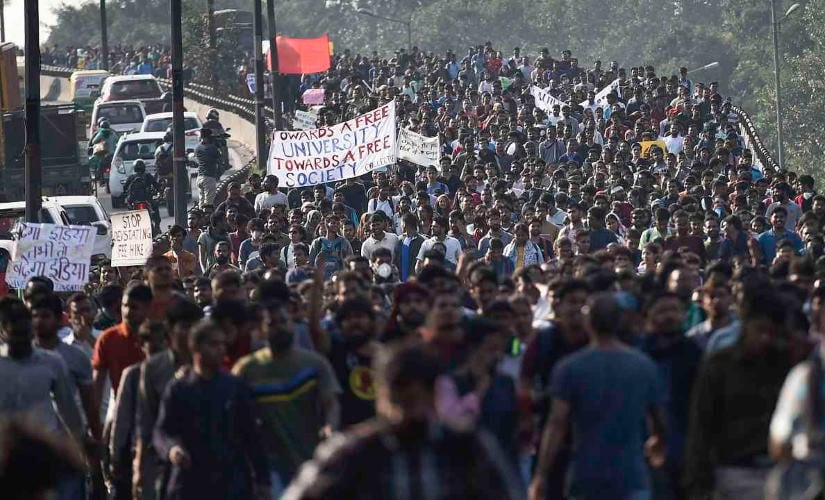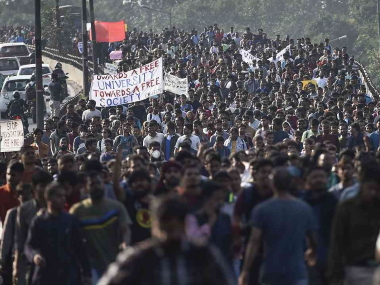Hum bhi dekhenge, hum bhi dekhenge Jab zulm-o-sitam ke koh-e-garan Rooyi ki tarah ud jayenge, hum dekhenge We, too, shall see. We also shall see When the mountains of oppression and cruelty. Will float away like carded wool. We will see. Faiz Ahmed Faiz’s Hum Dekhenge (1979) is the anthem of anti-Citizenship Amendment Act protests nationwide. It doesn’t matter that it’s in Urdu, a language the majority doesn’t read or speak. It’s being sung late into the night by crowds in Delhi, Vadodara, Pune, and Mumbai. [caption id=“attachment_7876921” align=“alignnone” width=“825”]  Representational image. PTI[/caption] If you are a protest regular you will know that those demanding justice for Jawaharlal Nehru University and the repealment of CAA have a protest playlist. Bismil Azimabadi’s Sarfaroshi Ki Tamanna (1921), Makhdoom Mohiuddin’s Jang-e-Azadi, Amsi Narayanapilla’s Varika Varika Sahajare and Pash’s Sabse Khatarnak — works that were written during the freedom struggle are part of it. But there’s more. A thriving culture of protest in India is facilitating the creation of original works. It’s customised for 2020, Narendra Modi, Amit Shah and CAA. The songs are catchy. The beats are fast. The structure is verse/chorus/verse/chorus/bridge/chorus — typical of pop songs. The lyrics, potent. The themes are similar to Strange Fruit, which was about the lynching of African Americans in the 1930s and considered to be the most heart-wrenching protest song of all times. Southern trees bear a strange fruit/ Blood on the leaves and blood at the root/ Black bodies swinging in the southern breeze/ Strange fruit hanging from the poplar trees But juxtapose these lines against those of Varun Grover’s or law student and protest poet Iqra Khan’s, and you will realise that these Indian artists are more direct. Metaphors and allegories are few. Their work is a straightforward demand for revolution, for action, much like their tweets. — Grover’s Hum Kagaz Nahin Dikhayenge that went viral: Tanashah aake jayenge, hum kagaz nahi dikhayenge, Tum aasoon gas uchaloge, zeher ki chai ubaloge, Hum pyar ki shakkar ghol ke usko, gat gat pee jayenge, Hum kagaz nahin dikhayenge, Ye desh hi apna hasil hai, Jahan Ram Prasad bhi bismil hai Mitti ko kaise baantonge, sabka khoon toh shamil hai, Tum police se lath padadoge, Metro band karadoge, Hum paidal paidal aayenge, Hum kagaz nahin dikhayenge. Hum manji yahin bichange Hum kagaz nahin dikhanyenge Hum samvidhan ko bachayenge Hum kagaz nahin dikhanyenge — A verse from Iqra Khan’s poem: Tum khanik ho, mistari hum, Har hunar ka naaz ho tum, Phir chhida hai is hawa se, Woh purana saaz ho tum… …Ab katar do bediyan ye, Hausle phir sakht kar do, Deemako se tum jo thehre, Dhul ab ye takht kar do… You are the miner, you are the mason, The mechanic, You are the pride of every skill, In sync again with the winds of revolution, You are a musical instrument Break these shackles, Strengthen your resolve, They’ve called you termites Now, turn this throne to dust For the woke millennial, Instagram and Twitter are no longer just for pretty pictures and likes. Social media is step-1 of the revolution. Subreddits inform you of protest venues and schedules, Twitter updates you about police permissions, changes and detentions and Instagram’s stories reveal your politics. Ghazals, sketches and poems are the aam aadmi’s everyday thing. On my Facebook feed, HR professional Rukkini Sen’s free verse showed up on 5 January: Godman says hum badla lenge Young boys in jail bleed from violation Humanity bled Until there’s nothing left except for a terrorist People whistle as they walk by Put on their headphones to numb out the screaming Roll up the windows of their Mercedes They say, “ This is India. We have too many. No place for any more.” The bleeding boy hears them. All of 14. Terrorism sounds like a good deal now. To deal with political terrorists, one needs to be A terrorist, he thinks. College campuses nationwide are rife with chants of azaadi, the chant that Kanhiya Kumar gave us in 2016: Hai haq hamara, aazadi Hum lekar rahenge, aazadi Sangvaad se, aazadi Bhukhmari se, aazadi… …Tum kuch bhi karlo Hum lekar rahenge, aazadi In 2020, the list has grown longer. Internet shutdowns, fake news, CAA, NRC… sabse aazadi. This song, performed at a Chhatra Bharti event at Yashwantrao Chavan Centre in Mumbai on 5 January, calls the BJP government fascist. The crowd sang along, obviously entertained. And for those who weren’t interested in the rhetoric of student leaders, the simple stanzas on CAB clarified what the amendment meant: Hum bharatvasi kehte hai sunlo In naziyon se desh bachao Aaya hai nazi, laya hai nazi, Bola pehchan karao varna jao jao jao Jab uska man ho, kehta hai humse Karoonga zulm aur sitam, sehte jao jao jao Chu mat karna, ghut ghut ke marna Bhooka rakhoonga Beta jao jao jao In the last decade, the country has seen many powerful protests — 2011: Anti-corruption and Jan Lokpal, 2012: Nirbhaya, 2014: Jadavpur University protest, 2015: FTII agitation, 2016: The Afzal Guru and Rohith Vemula protests and 2017: The Pro-Jallikattu protests. But the current anti-CAA protests have been the most violent. With over 25 dead, more than 1,000 arrested and more than 5,500 in detention, the costs for participation in this protest are high, especially if you’re in Delhi and Uttar Pradesh. As the state increases its atrocities, the number of dissenters increases. Even Bollywood, that has traditionally been “apolitical” for obvious reasons, has come out on the streets in solidarity with JNU. While protests in the north are getting increasingly violent, the call for student-led protests throughout the country has been for peaceful resistance. “Come with water, blankets, food and newspapers,” most protest invitations say. At Gateway of India, the vibe was one of celebration. There were songs, sandwiches, bananas, Appy and chai. Students were painting posters and picnicking. That ended on the morning of the 7th, with the Mumbai police clearing the Gateway site and moving protesters to Azad Maidan. Protest art does many things, but two of the most important are — 1) forming public opinion on a serious subject in a creative fashion 2) authentically documenting the goals and intentions of a campaign through which measuring the success of the protest becomes easy. There is a lot that humour, music and theatre can do, that serious speeches and the news can’t. In early 2019, I’d attended Kunal Kamra’s stand-up act in Ahmedabad. He made a joke about a common question that people were asking before the general elections. “If not Modi, then who?” Kunal Kamra’s response was, “Whoever. Kisi ko bhi le lao, inko nikalo.” It simplified for many what many long editorials didn’t. It didn’t matter if Rahul Gandhi or the Congress, in general, were incompetent or corrupt, at least they didn’t pose the problem of an existential crisis for the Muslim community. Around the same time, in the lobby of a doctor’s office, I found myself sitting next to a Muslim gentleman. We chatted about his work and family and then I broached the subject of politics. He bent down and whispered into my ear, “Mein Muslim hoon”. His long beard and skull made that clear the moment one noticed him, but the fact that he wanted to secretly whisper his religious identity to me in my ear, made me wonder how unsafe this individual felt. He answered my question on political belief with a question of his own, “Maut aur mohtaj mein behtar kya hai” (What’s the choice between poverty and death?). But the anti-CAA protests are clear, they’re fighting for the secular idea of India. And while protesters have been safer in non-BJP states, they’re not extolling the values of the Congress or any other opposition party. They don’t want the movement hijacked. To the aam aadmi, no political party offers any hope. “Ye sab chor hai. Inko desh ka pada nahi hai. Ayenge, jeb bhar ke jayenge,” my Uber driver on the ride back from Gateway told me. Poet Naveen Chourey, says it best: Rang, bhasha, pranti, link aur jaat, mazhab Baantne pe tul gaya hai hukmran jab Aman ka ailan sadko pe nikal ke hum karenge Hum ladenge, hum ladenge, hum ladenge…
A thriving culture of protest in India is facilitating creation of original work. The beats are fast. The structure is verse/chorus/verse/chorus/bridge/chorus — typical of pop songs. The lyrics, potent.
Advertisement
End of Article


)
)
)
)
)
)
)
)
)



